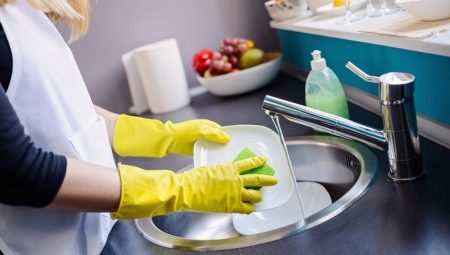In everyday life, every housewife is faced with the need to perform household chores, which includes cleaning the floors, sanitary cleaning of the bathroom, dusting, washing and much more. But most often you have to deal with washing dishes. Well, if the family budget allows you to purchase a dishwasher, and if this is not possible? In this case, rubber gloves will be indispensable helpers in the kitchen. They protect the vulnerable skin of the hands from the negative effects of chemicals and water.
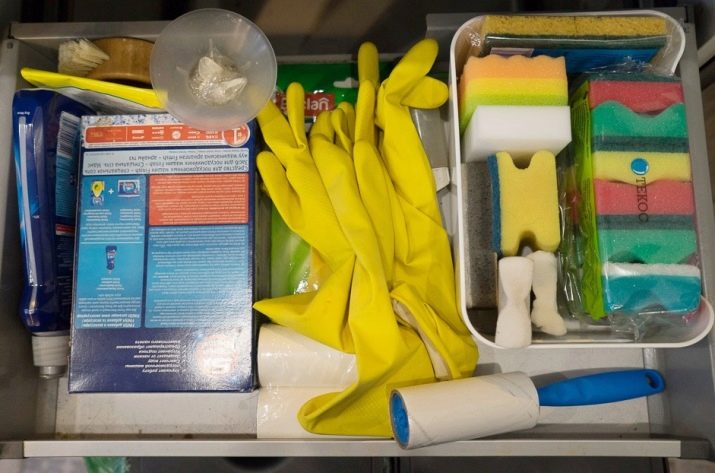
Characteristic
Kitchen utensils are often cleaned using special chemicals. It is well known that all powders and dishwashing liquids cause serious damage to the delicate skin of the hands. Even simple cold or hot water can affect the condition of the skin, making it dry and rough.

Dishwashing gloves - This is a special product that is designed to protect hands during the washing and cleaning of kitchen utensils.
To ensure the safety and comfort of the hands are at a high level, gloves must meet the list of requirements.
- High strength. Products must be resistant to foreign objects and chemicals.
- Endurance and durability. Protective equipment must withstand the load for which it is intended for as long as possible.
- Quality material. The hostess's sense of comfort depends on the material, because the use of high-quality fiber in the manufacture of this protective product allows you to feel those objects that are in your hands when washing.
- Suitable size. If the hostess refuses the dimensionless gloves and selects her size correctly, she will not even feel the protective equipment on her hands, but at the same time they will be protected.
The economic market is very large and diverse.
Modern manufacturers provide a huge selection of hand protection, which can be made of latex, silicone, rubber and other materials. What kind of preference to give, only the buyer decides.


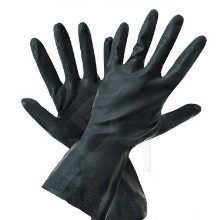
Kinds
Depending on the material from which the protective equipment is made, products are divided into 3 main types.
Silicone
Silicone gloves in most cases have special villi with which you can wash the dishes without using sponges or other devices. In this case, protective equipment plays the role of a brush, which effectively and efficiently cleans the plates of any kind of contamination.
Silicone gloves have several advantages, among which it is worth highlighting:
- the ability to wash dishes without the use of brushes and sponges;
- instant foam formation;
- high temperature resistance;
- strength;
- softness;
- flexibility.
Despite the abundance of advantages, this type of mittens has 2 significant drawbacks: low elasticity and low sensitivity.
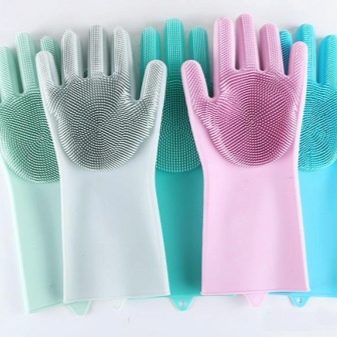

Rubber
Rubber gloves have a wide range of applications in everyday life and household due to the fact that they can be made of 3 types of synthetic materials: neoprene, nitrile or polyvinyl chloride.
When choosing one or another type, one should take into account the fact that personal protective equipment made of natural rubber with an admixture of neoprene has the greatest strength.
Fine work will be easier and more convenient to do with nitrile gloves, since such a material has increased elasticity and a high degree of resistance to tearing.

Comfortable use of protection against detergents will provide cotton covered inside (thanks to this breathable fiber, your hands will not sweat). In addition, these gloves are hypoallergenic and suitable for almost any type of skin.
The following advantages that rubber gloves have are distinguished:
- increased resistance to chemicals;
- high level of strength to mechanical stress (cuts, punctures);
- lack of slip.
The disadvantages of rubber products include:
- low level of elasticity (weakly stretched);
- lack of sensitivity when working with small parts.

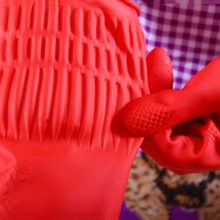
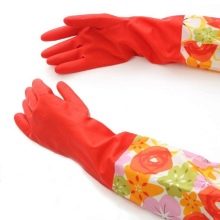
Latex
The most popular and sought after gloves are made of latex. This is explained by such personal protective equipment is thinner and lighter, quite durable and has a high degree of elasticity. Unfortunately, this species is also present A number of negative aspects that should be taken into account, giving preference to this type of gloves:
- high risk of cuts;
- too tight and tight fitting hands;
- high level of slip;
- low degree of resistance to adverse effects from aggressive chemicals.
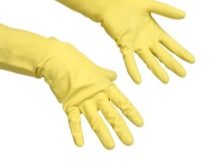
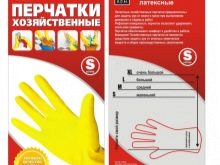
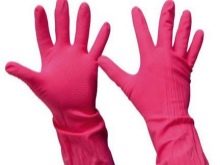
Features of choice
To easily choose gloves for washing dishes, you should pay attention to some features.
- Size range: S, M, L, XL, XXL. Personal protective equipment should be easy to put on and take off. Using the size chart indicated on the glove box, you can easily find the right size.
- Destination. When choosing, you need to take into account and analyze all factors: whether there will be an interaction with strong chemical agents, whether there is a risk of damage to personal protective equipment, whether the selected material can provide skin comfort with individual characteristics. A universal dishwashing detergent will be mittens made of artificial materials.
- Sleeve length. The choice depends on personal preference and scope. It is clear that the longer the sleeves, the greater the area of skin protection from the harmful effects of chemicals.
But do not discount the fact that too high gloves hamper the movement. This factor should be considered individually in each case.

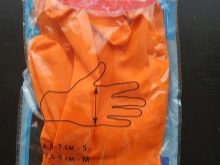

Terms of use
When using personal protective equipment such as dishwashing gloves, a number of recommendations must be observed.
- Gloves need put on dry clean hands.
- Before using the protective equipment, it must be carefully Inspect for tears, cracks, or factory defects. If there are flaws, it is better to refuse to use gloves.
- Extremely handle sharp and sharp objects carefully (with forks and knives), as the gloves are not able to protect against their dangerous effects (cuts and punctures).
- Observe utmost care when handling fragile dishes, since the sensitivity in gloves is significantly reduced.
- When choosing mittens preference should be given to products having a special corrugationdue to which the reliability of holding items in the hands is increased, and the risk of damage to dishes will be minimized.
- The types of gloves listed above can only be used for washing dishes. They absolutely can not be used when working with solvents, gasoline or technical oils. For such cases, it is necessary to purchase specialized personal protective equipment.
- Easy, high-quality and quick to wash the dishes will allow gloves with bristles or bristles.
- If you experience discomfort while washing dishes with gloves check their size. Gloves should be easy to take off and put on.
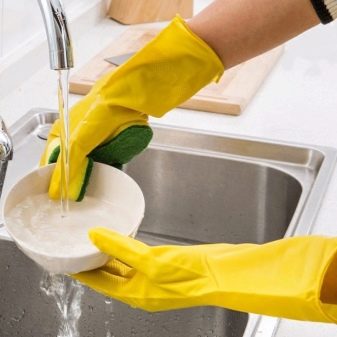
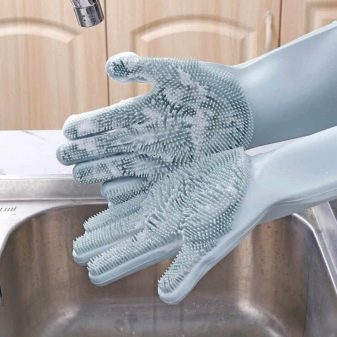
To extend the service life of household gloves, a number of certain rules must be observed.
- Mittens are stored in their original packaging in a room with moderate or low humidity, and the temperature should be in the range from +5 to + 25 °. The place where the gloves will lie should be isolated from heaters.
- Avoid direct sunlight. The material from which the gloves are made, under the prolonged exposure to the sun, can lose its protective properties, and sometimes even melt.
- At the end of the application, gloves should be washed to get rid of contaminants and chemical residues.
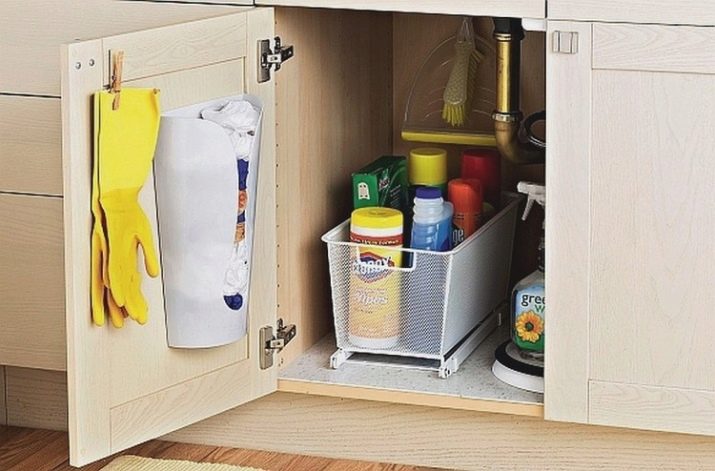
The following video provides a video overview of universal silicone gloves with a pile for cleaning.
